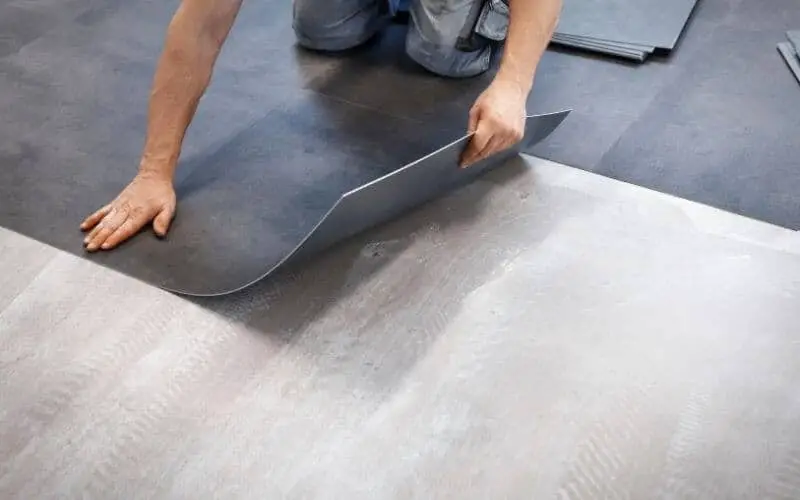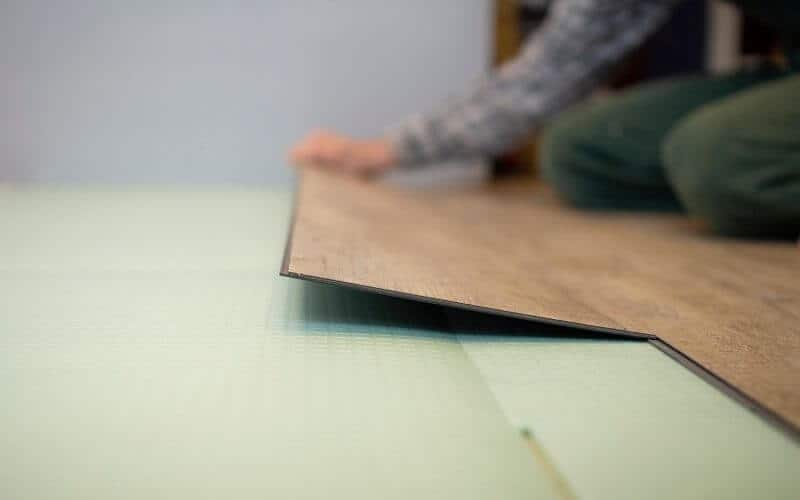There are multiple flooring options in the market, but despite these abounding choices—ceramic tile, hardwood, engineered wood and laminate and vinyl flooring remains the most sought after.
According to statistics, vinyl flooring accounts for almost 18 percent of the flooring industry’s overall sales volume in the US. This goes to show that the flooring has an impressive consumer acceptance.
But does that make vinyl flooring good or bad? Well, here are the pros and cons of vinyl flooring, so you can be the judge of that.
Read: How hard is it to install vinyl flooring
Pros And Of Vinyl Flooring
Table of Contents
Comfortable
Walking over vinyl flooring with boots or barefoot feels more comfortable than other flooring options. Vinyl flooring has a slightly softer walking surface which muffles the sound of your steps as well.
The flooring product is produced with a thin backing of resilient foam or felt, making the floor slightly more shock-absorbent and less tiring to walk across or stand upon for a long time.
This also makes vinyl a little warmer to bare feet than ceramic or stone flooring, especially on a cold morning.
Variety of Available Options
Vinyl flooring is a product with an unlimited number of manufacturers and product choices. With an extra-large footprint in the marketplace and numerous manufacturers, you can rest assured that you’ll find a wide variety of vinyl colors and styles that matches virtually any design theme you want.
Highly Durable
Vinyl flooring can withstand normal household wear and tear; it is made from durable materials that do not require strenuous maintenance to keep it in good condition or prevent expensive damage.
Many vinyl floorings come with a 15-year warranty against premature wear and damage. This, however, is a baseline figure, manufacturers know their product’s and the expected service life better than anyone, and they generally adjust the terms of their guarantee to accommodate that figure.
When properly installed and given normal maintenance, vinyl flooring can last 20 years or more. You can get an even lasting flooring if you choose sheet vinyl over tiles.
Vinyl flooring is also impervious as the seams, which contributes to the deterioration and moisture infiltration of most flooring types, are very few in the flooring. This is because it is typically installed as one piece or only a very few continuous pieces; this ensures optimum durability.
Read: How to whiten vinyl floors
Easy Installation
Vinyl flooring does not require any burdensome installation procedure. As long as the sub-floor in the room is intact and level, you do not need to make any modifications or improvements to the vinyl tiles or sheets before installing.
If you already have an existing vinyl flooring that is still in good shape, you can install vinyl directly atop the existing flooring.
If you want to install the flooring yourself, you can opt for peel-and-stick vinyl tiles with adhesive already applied to the backing; this makes the installation process a lot easier, and you get to save on installation costs.
Sheet vinyl is also easy to install; it needs to be rolled out and installed as a single piece; however, for more expensive products like LVT, you might want to let professionals handle the job.
Read: How easy is it to install vinyl flooring
Low Maintenance
Vinyl flooring is one of the lowest maintenance floors around; this makes it the perfect flooring for residential and commercial areas.
You simply need to sweep regularly, clean up tough stains with a damp mop and, when needed, apply a commercial product to revive the floor’s lustre.
But this doesn’t mean you can treat the floor without caution; common caveats particular to most flooring material still applies. Avoid dropping heavy and sharp objects on the floor and clean up stains and spills promptly.
Customizable Affordability
You can decide to go all out with vinyl flooring or stick with your budget. It all depends on how much you want to spend and the look you are going for.
On the low end, you can opt for DIY peel-and-stick checkerboard tiles or lush, photo-realistic LVT custom-installed by professionals if you are feeling fancy. This means the cost of vinyl can run from a few hundred to a couple of thousands and everything in-between.
Read: Pros and Cons of vinyl flooring
Cons Of Vinyl Flooring
Surface Susceptibility to Cuts
Vinyl flooring has a spongy soft feel, making the material prone to cuts and gouges from sharp objects.
This is particularly more of a concern if the vinyl is in a kitchen environment or where a single-sheet vinyl is installed. The feet of heavy furniture can also damage vinyl flooring, so you might want to place furniture pads under the feet.
Read: How to move furniture without scratching floor
Indoor Environmental Concerns
Vinyl flooring is a byproduct of petrochemicals and sometimes release vapors known as volatile organic compounds (VOCs) into the indoor air, especially when it is newly installed.
Keep in mind that VOCs are and always have been emitted by other building materials, including other floorings such as laminated wood and carpeting.
Has Zero Marginal Effect On Home Value
Certain types of high-end flooring, such as hardwood or imported ceramic tile, sometimes boost the resale value of a home; vinyl flooring, however, isn’t a major contributor to a higher home value. There might be an exception for today’s more pricey luxury vinyl tile (LVT).
Read: What causes yellow stain on vinyl flooring
Conclusion
The question isn’t about vinyl flooring being good or bad; it is about it being the right flooring for you. Weigh the pros and cons of vinyl flooring carefully so you can make your own informed buying decision.
Vinyl flooring is available in a diverse range of choices, so you can choose the one that fits your aesthetic goals, lifestyle, and budget.


